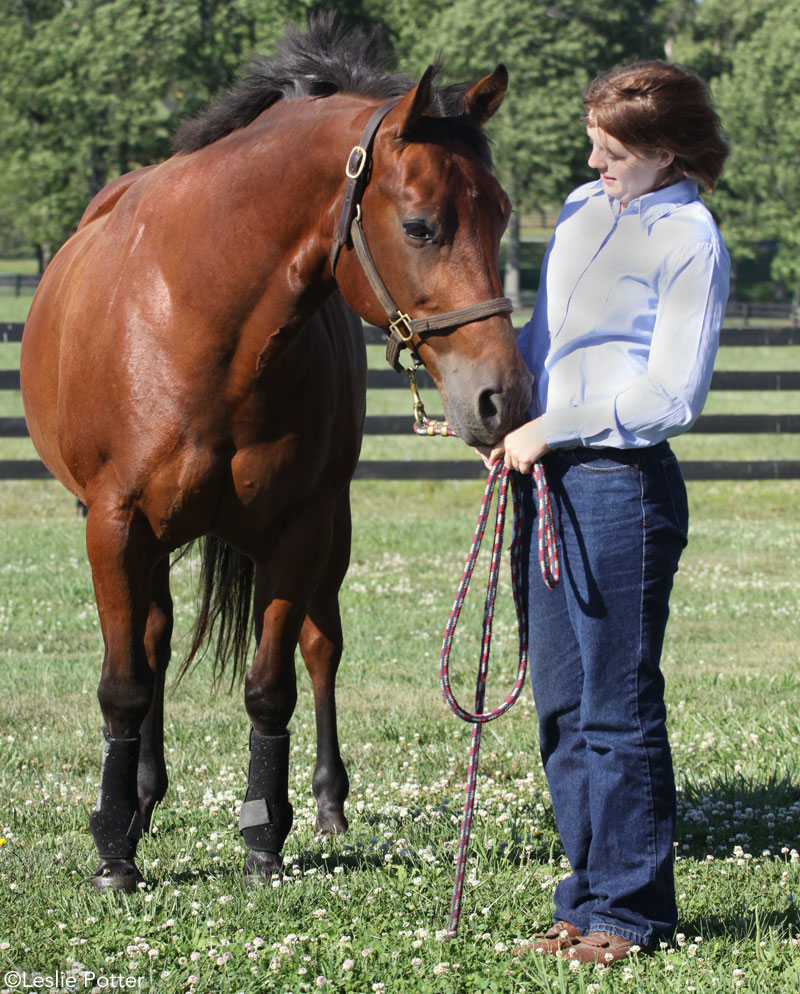
There are many important skills for when the vet visits for your horse to learn, including standing still. Read for tips on preparing your horse for such a visit.
If your horse is emotional and riled up when the veterinarian is present, he may not react well to sedatives. He may also develop a fear of the veterinarian or a fear of being touched where his injury is. And if your horse acts up in a dramatic fashion, it can endanger your vet.
I prefer not to have my horses tranquilized unless absolutely necessary. For routine care or surface-level wound care, I rely on my horse’s training and willingness to focus on me. If my horse knows the rules and stays calm, the veterinarian can quickly get the job done. If I can do something ahead of time to train the horse to be cooperative, I want to do that instead of administering sedatives.
If your horse can stand still on command, pick up and hold up his hooves, and tolerate touch in and around his eyes, ears and mouth, you can help your vet and remind your horse of his training when needed.
Patient Skills
Standing Still: Your horse should stand as still as a statue on command: posed with all four hooves on the ground and his nose straight in front of his chest. Once you give the command to stand still, your horse shouldn’t move a hoof unless asked to move. Also, your horse shouldn’t move to place his nose or mouth on the veterinarian.
Touching and “lipping” the vet or farrier (or anyone leaning over to work on your horse’s legs or hooves) can quickly lead to biting. Your horse should keep his head in front of his chest any time you ask him to stand still.
Teach your horse to stand still on command by outfitting him in a rope halter with an attached long lead. Ask your horse to stop after you place yourself in position. Stand slightly in front of your horse’s nose and out to the side, so that you’re safely out of his way if he decides to run forward. Point your feet toward your horse’s shoulder as you hold the long line with some slack.
You aren’t holding your horse still with your muscles, but teaching him he must stand still on his own. If your horse turns his head past the corner of his chest or moves a foot, snap your wrist to send a wave through the lead line. If your corrections are timed close to the moment your horse moves, he’ll quickly associate the consequence with his movement and learn to stand still.
Spend time with your horse regularly and practice this skill each time you lead him. If you practice regularly, your horse will remember the cue (your body position) and perform his stand-still routine when the veterinarian needs to examine him.
Pick Up and Hold: Your horse may easily pick up each hoof on command, but will he keep that hoof in the air for examination and treatment? It’s easy to train a horse to pick up his hooves, but many horses aren’t taught to keep their hooves up.
Hoof handling is also important if you need to place your horse’s hoof on the right spot for a radiograph or to provide treatment. You’ll need your horse to allow you to place his hoof where you want if you need to soak a hoof abscess or ice a leg wound.
To make sure your horse won’t jerk his hoof away during an exam (or any time you’re working with him), make sure you gently place his hoof down each time you pick his feet. Don’t drop your horse’s hooves, but purposefully place them down once you’re done. Your horse balances on you as you hold up his hoof, so it’s jarring if you drop it quickly. Plus, dropping the hoof will teach your horse that he can pull away. He won’t learn to pull away if you cautiously place his hoof down every time you handle his feet.
Handling: As you’re getting a horse used to being handled, make sure that you handle his ears and mouth. Your horse should accept touch everywhere. Make sure to routinely pet your horse all over. Make sure that your horse will accept your touch on his gums (to check capillary refill) as well as around his eyes, inside his ears, and under his belly and back legs. An injury can occur anywhere, so your horse must not fear being touched in any location.
Make this touch part of your grooming time. Don’t be rude or abrupt, and don’t endanger yourself by putting your fingers between your horse’s teeth, but gently rub a new area then take away pressure when he accepts it. If your horse raises his head or pulls away, stay with him and continue the touch. Once he relaxes, stop and turn your back to give him a release of pressure.
In the Moment: What can you do to help the veterinarian and keep your horse calm when the veterinarian is present? First, know where to stand and what your veterinarian needs to do. It’s usually best for you and the veterinarian to stand on the same side of your horse. This positioning will allow your horse to focus on just one side—instead of worrying about what’s happening on both sides of his body. It will also allow a scared horse to have a place to move into without running into a person.
You may need to distract your horse. Scratching your horse on the forehead or neck and talking to him can help keep his attention on you instead of the veterinarian. Sometimes I’ll tap rhythmically on my horse’s forehead. This seems to soothe him and give him something to focus on. If you’ve asked your horse to stand still, simply wiggling the rope may hold his attention (as long as that isn’t also your cue to back up).
What to do if He Won’t Stand Still
There may be a time when I have to restrain a horse with a shoulder twitch or by holding the halter. I might just twist the noseband of the halter to tighten it a bit. I can also take a hold of the lead rope so that the horse has a little more tension and reminder that he’s being held.
If your horse becomes fearful or agitated, ask your veterinarian to pause while you reset your horse or correct him for moving around. Remind your horse of his training. While you don’t want to make your vet wait through a lengthy training session, it’s fine to ask for a break if you think your horse may settle down.
Keep in mind that even the most well-mannered horse can become fearful if he’s hurt. And sometimes pain can be so great that even the best distractions don’t work. If you’ve worked with your horse to teach him manners and you’ve done all you can to help him stay calm, know that you’ve done your best. Your vet’s safety (and your own) are important, and there is a time and place for sedation.
Communicate clearly with your veterinarian and ask what you can do to help. Keep in mind that you’re both working together for your horse’s safety and health. Together with consistent training and clear communication when an emergency strikes, you can help your horse be the best possible patient.
This article about teaching your horse to stand still originally appeared in the February 2018 issue of Horse Illustrated magazine. Click here to subscribe!






